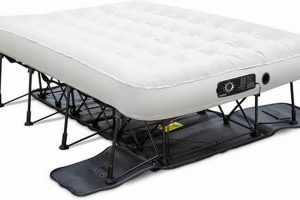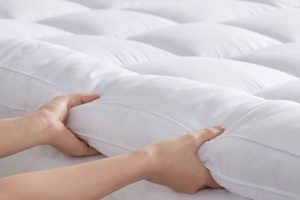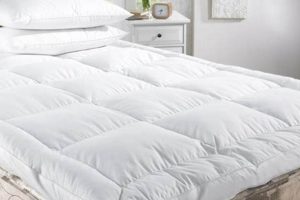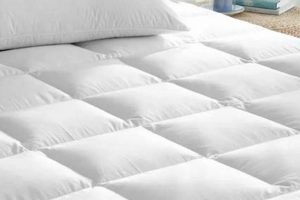A supplementary layer designed to be placed atop an existing bed, intended to improve comfort, support, or both. These additions are often employed to address issues with an aging or uncomfortable sleep surface, providing an extra cushion or modifying the firmness level. One specific application involves mitigating the effects of diminished support, where the underlying bed has begun to lose its original structural integrity and no longer adequately prevents sinking or unevenness.
The strategic use of an overlay can offer a cost-effective alternative to complete bed replacement. Benefits extend beyond simple comfort; a suitable product can promote proper spinal alignment, reduce pressure points, and contribute to a more restful night’s sleep. Historically, less sophisticated versions were utilized, often consisting of simple padding or featherbeds. Modern iterations, however, incorporate advanced materials such as memory foam, latex, and various synthetic blends, each offering unique performance characteristics. The selection of appropriate material and thickness depends largely on the degree of support loss experienced and the desired outcome.
The subsequent sections will delve into the specific types of materials used in these overlays, comparing their performance characteristics, identifying ideal candidates for their use, and providing guidance on selection and maintenance to maximize lifespan and effectiveness.
Tips for Selecting an Overlay for a Deteriorated Bed
This section offers critical insights for individuals seeking to enhance a sleep surface that exhibits signs of structural failure. Choosing the appropriate model demands careful consideration of several factors to ensure optimal comfort and support.
Tip 1: Assess the Degree of Sag. Prior to purchase, thoroughly evaluate the extent of the depression. Minor surface imperfections may be adequately addressed with a relatively thin overlay. Significant sagging, however, requires a thicker, denser material to provide sufficient restorative support.
Tip 2: Consider Material Density. Higher-density materials, such as memory foam or latex, generally offer greater resistance to compression and provide longer-lasting support. Lower-density options may initially feel comfortable but can quickly flatten and lose their effectiveness.
Tip 3: Evaluate Spinal Alignment. The primary goal is to restore proper spinal alignment. Test different firmness levels to determine which provides the most comfortable and supportive sleeping position. Avoid excessively soft options that may exacerbate alignment issues.
Tip 4: Check for Edge Support. If the existing bed has weak or collapsing edges, select an overlay with reinforced edge support to prevent roll-off and maximize usable sleep surface.
Tip 5: Review Warranty and Return Policies. Ensure the product is covered by a comprehensive warranty that protects against premature sagging or material defects. Additionally, verify the retailer’s return policy in case the selected model proves unsuitable.
Tip 6: Consider Weight Distribution. For couples, consider an option that effectively isolates motion to minimize partner disturbance caused by movement during the night. This is especially crucial if there is a significant weight difference between partners.
Tip 7: Factor in Ventilation. Overlays made of materials like memory foam can retain heat. If overheating is a concern, look for options with cooling gel infusions or open-cell structures to promote airflow and regulate temperature.
By adhering to these guidelines, individuals can make informed decisions to enhance the comfort and longevity of their sleep environment, thereby avoiding the more significant expense of a complete bed replacement.
The following section will address common misconceptions associated with overlay usage and explore alternative solutions for addressing significant support issues.
1. Material Density
Material density plays a crucial role in the effectiveness of a supplemental layer designed to compensate for diminished support in an existing bed. Density, measured in pounds per cubic foot (PCF), directly correlates with the ability of the overlay to resist compression and provide sustained support over time. Lower density materials, while initially comfortable, are prone to rapid degradation under consistent pressure, quickly losing their ability to alleviate sagging and resulting in a diminished sleep experience. Conversely, higher density materials offer greater resistance to deformation, providing a more stable and consistent surface for improved spinal alignment and pressure relief. For instance, a 4 PCF memory foam option will generally provide significantly more durable and effective support than a 2 PCF counterpart in mitigating the effects of a sunken sleep surface.
The practical significance of understanding density lies in its direct impact on the longevity and performance of the supplemental layer. Consider a scenario where an individual purchases a low-density memory foam overlay to address moderate sagging. While the initial impression may be positive, the material’s inability to withstand prolonged compression will lead to accelerated flattening, rendering it ineffective within a relatively short timeframe. In contrast, a higher density latex or memory foam option, despite a potentially higher upfront cost, will maintain its structural integrity for a significantly longer period, offering a more sustainable and cost-effective solution in the long run. The impact extends beyond just support; materials with greater density often exhibit superior motion isolation, further enhancing sleep quality for individuals sharing a bed.
In summary, selecting a supplemental layer for a deteriorating sleep surface necessitates a careful evaluation of material density. While factors like comfort and price point are important considerations, density serves as a critical indicator of long-term performance and effectiveness in addressing the underlying issue of diminished support. Overlooking this aspect can lead to premature product failure and continued discomfort, ultimately negating the intended benefits of the overlay.
2. Thickness Considerations
Thickness represents a critical parameter in determining the effectiveness of a supplemental layer intended to compensate for surface depressions. Insufficient depth will fail to provide adequate support, while excessive depth may create an unstable or uncomfortable sleep environment. Appropriate dimensioning depends heavily on the extent of the underlying bed’s deterioration and the individual’s preferences.
- Degree of Sag Correction
The primary function of increased thickness is to compensate for lost support and restore a level sleeping surface. A severely sunken
bed requires a substantial depth to effectively level the sleeping area. Selecting insufficient thickness results in continued unevenness and discomfort, negating the benefits of the overlay. Example: A bed with a 3-inch sag necessitates an overlay of at least 3 inches, potentially more, depending on material density, to create a flat surface. - Material Compression Rate
The compression rate of the material influences the required thickness. High-compression materials require greater initial depth to maintain support under body weight. Low-compression materials, such as some latex foams, may achieve a similar level of support with less thickness. Selecting overlay materials without accounting for compression rates can lead to an underestimation of the required depth and, consequently, inadequate support.
- Body Weight and Distribution
The sleeper’s body weight and distribution pattern significantly impact the required thickness. Individuals with higher body weights require thicker, denser overlays to prevent bottoming out and maintain spinal alignment. Uneven weight distribution patterns, such as concentrated pressure on the hips or shoulders, necessitate strategic thickness variations or zoning within the overlay to provide targeted support. Failing to consider these factors can lead to localized pressure points and discomfort.
- Edge Support Degradation
If the original bed exhibits diminished edge support, the supplemental layer’s thickness becomes particularly important in preventing roll-off. A thicker overlay, especially one with reinforced edges, can extend the usable sleep surface and improve stability. Neglecting this consideration can result in a feeling of instability and a reduced sense of security, particularly for those who sleep near the edge of the bed.
In summation, optimal thickness selection requires a comprehensive assessment of the degree of sagging, material compression characteristics, the sleeper’s body weight and distribution, and the condition of the bed’s edges. A properly dimensioned overlay will effectively address the specific support deficiencies, resulting in improved comfort, spinal alignment, and overall sleep quality. Overlooking these factors results in a compromise of the overlay’s intended benefits and may ultimately necessitate a more costly bed replacement.
3. Support Restoration
Support restoration, when referring to a supplemental layer atop a declining sleep surface, aims to re-establish the intended level of firmness and minimize the adverse effects of sinking and unevenness. The extent to which this is achieved directly influences comfort, spinal alignment, and overall sleep quality.
- Material Properties and Rebound Capacity
The intrinsic characteristics of the material utilized in the layer dictate its ability to counteract the effects of a deficient support structure. High-density memory foam or latex, for example, exhibit superior rebound capacity compared to less dense alternatives, enabling them to maintain their shape and provide consistent lift. A bed exhibiting significant sagging may require a high-rebound material to effectively fill the void and prevent continued sinking.
- Weight Distribution and Pressure Point Mitigation
An effective support restoration strategy considers the distribution of body weight and the formation of pressure points. An overlay designed to redistribute weight can alleviate stress on specific areas, such as the hips and shoulders, promoting a more balanced and comfortable sleep posture. This is particularly relevant for individuals experiencing back pain or discomfort due to an uneven sleeping surface.
- Edge Support and Perimeter Stability
The perimeter of a bed often experiences accelerated wear and tear, leading to reduced edge support. A supplemental layer with reinforced edges can compensate for this deficiency, preventing roll-off and maximizing the usable sleep surface. The presence of robust edge support contributes to a sense of security and stability, particularly for those who sleep near the edge.
- Long-Term Durability and Sag Resistance
The ability of the supplemental layer to maintain its support properties over an extended period is a crucial factor in achieving lasting support restoration. Overlays made from materials prone to compression and degradation will quickly lose their effectiveness, necessitating frequent replacement. Selecting durable, sag-resistant materials ensures long-term performance and avoids the need for repeated investments.
These facets of support restoration are interdependent and collectively determine the efficacy of a surface overlay in mitigating the effects of a deteriorating bed. The selection of appropriate materials, the consideration of weight distribution, the reinforcement of edge support, and the emphasis on long-term durability are all essential components of a successful strategy for restoring a comfortable and supportive sleep environment.
4. Spinal Alignment
Maintaining correct spinal alignment during sleep is crucial for overall health and well-being. A compromised sleep surface can disrupt natural spinal curvature, leading to discomfort, pain, and potential long-term musculoskeletal issues. Employing a supplemental layer to address deficiencies in a bed is often considered as a means to restore proper spinal support.
- Restoring Natural Curvature
The natural spine exhibits a series of gentle curves that distribute weight and absorb shock. A sagging bed forces the spine out of its natural alignment, creating stress on supporting muscles and ligaments. A properly selected supplemental layer provides uniform support, filling voids and restoring the spine’s natural curvature. For example, a side sleeper on a sagging bed might experience spinal curvature due to uneven support. A well-chosen overlay corrects this by providing consistent support along the length of the body.
- Pressure Point Reduction
Misalignment concentrates pressure on specific points along the spine, such as the hips and shoulders. This pressure can restrict blood flow and cause discomfort. A supplemental layer, particularly one made of memory foam or latex, conforms to the body’s contours, distributing weight more evenly and reducing pressure points. A person with scoliosis, for instance, might benefit from the pressure relief offered by a memory foam model designed to provide targeted support.
- Muscle Relaxation and Recovery
When the spine is misaligned, surrounding muscles must work harder to maintain stability. This constant muscle tension can lead to stiffness and pain. Restoring proper alignment allows these muscles to relax, promoting recovery and reducing discomfort. An athlete, for example, might use a supplementary layer to aid muscle recovery by ensuring proper spinal alignment during sleep, minimizing muscle strain.
- Long-Term Spinal Health
Chronic spinal misalignment can contribute to the development of degenerative disc disease, arthritis, and other long-term musculoskeletal problems. By maintaining correct spinal alignment, a supplemental layer can help prevent these conditions. Individuals with pre-existing spinal conditions, such as herniate
d discs, may find that a supportive overlay helps to alleviate their symptoms and prevent further deterioration.
In summary, the connection between spinal alignment and the use of a surface enhancement layer is paramount. By addressing the deficiencies of a sagging bed, these layers can restore natural curvature, reduce pressure points, promote muscle relaxation, and contribute to long-term spinal health. The appropriate selection and use of a supplementary layer can therefore play a significant role in maintaining overall well-being.
5. Pressure Relief
Pressure relief, in the context of supplemental layers designed to enhance a deteriorated bed, refers to the reduction of concentrated force exerted on specific points of the body during sleep. The efficacy of such a layer in alleviating pressure points is a significant determinant of comfort and can influence sleep quality and musculoskeletal health.
- Conformity to Body Contours
Materials like memory foam and latex exhibit viscoelastic properties, allowing them to conform to the unique contours of the body. This conformity distributes weight more evenly across the sleeping surface, reducing pressure on prominent areas such as the hips, shoulders, and spine. For example, a side sleeper on a sagging innerspring bed may experience concentrated pressure on the shoulder and hip, leading to discomfort. A conforming overlay redistributes this pressure, promoting more restful sleep.
- Weight Redistribution and Support
Effective pressure relief involves not only conforming to the body but also providing adequate support to prevent sinking into the underlying bed. Overlays with varying firmness levels cater to different body weights and sleeping positions. A firmer option may be necessary for heavier individuals to prevent bottoming out, while a softer option may be more suitable for lighter individuals seeking enhanced cushioning. A strategically designed zone support can address specific pressure points, such as lumbar support for back sleepers.
- Impact on Circulation
Sustained pressure on certain areas of the body can restrict blood flow, leading to discomfort and potentially contributing to conditions such as restless leg syndrome. By reducing pressure points, a suitable overlay can improve circulation, promoting a more restful sleep experience and reducing the frequency of nighttime awakenings. Individuals with circulatory issues or those prone to numbness may find significant relief with a pressure-relieving addition.
- Long-Term Musculoskeletal Benefits
Chronic pressure points can contribute to the development of musculoskeletal pain and discomfort over time. By consistently reducing pressure, a supportive layer can help prevent or alleviate conditions such as back pain, hip pain, and sciatica. Investing in a high-quality overlay with pressure-relieving properties can therefore be considered a preventative measure for maintaining long-term musculoskeletal health.
The ability of a supplemental layer to effectively alleviate pressure points is a crucial determinant of its overall effectiveness in improving sleep quality and promoting musculoskeletal health. Consideration of material properties, firmness levels, and individualized needs is essential in selecting an option that provides optimal pressure relief and addresses the specific challenges posed by a bed exhibiting diminished support.
6. Lifespan Extension
The placement of a surface enhancement layer atop a deteriorated bed is often considered as a means of extending the functional lifespan of the existing sleep system. While such an addition cannot fully restore a bed to its original condition, it can mitigate the effects of sagging and unevenness, providing a more comfortable and supportive sleep surface for a limited time. The degree to which lifespan is extended is directly proportional to the severity of the bed’s deterioration and the quality and construction of the supplemental layer. A high-density memory foam or latex model, for instance, is more likely to prolong the usable life of a bed compared to a less robust fiberfill option.
The practical effect of extending a bed’s lifespan through the use of a supplementary layer translates directly to cost savings for the consumer. The purchase of a new sleep system represents a significant financial investment, and delaying this expenditure, even for a period of months or a few years, can be advantageous. Furthermore, the use of an overlay allows the consumer to postpone the disposal of the existing bed, reducing environmental impact and mitigating logistical challenges associated with disposal. However, the expectation of lifespan extension should remain realistic. A surface overlay is not a permanent solution and will eventually require replacement as the underlying bed continues to degrade.
In summary, the judicious use of a supplemental layer can indeed prolong the usable life of a bed exhibiting signs of decline. However, this strategy serves as a temporary measure to defer the purchase of a replacement sleep system. The effectiveness of lifespan extension is contingent upon the quality of the overlay and the degree of underlying deterioration. Consumers should maintain realistic expectations and recognize that, while beneficial, an overlay is not a substitute for a properly functioning and supportive bed.
7. Cost-Effectiveness
The implementation of a surface enhancement layer as a solution for a bed exhibiting diminished support is frequently evaluated in terms of its cost-effectiveness compared to complete bed replacement. The financial implications of purchasing a new sleep system often present a barrier for consumers. Surface enhancement layers offer a lower initial investment, allowing individuals to postpone the more substantial expenditure associated with a complete bed overhaul. The cost of such a layer varies based on materials, thickness, and brand, but typically remains significantly lower than the price of a new bed. For instance, a high-density memory foam model may cost several hundred dollars, whereas a comparable new bed could easily exceed one thousand dollars. This price differential makes a surface enhancement layer an attractive option for individuals on a budget or those seeking a temporary solution.
However, a thorough cost-effectiveness analysis requires considering the long-term implications of both options. While a surface enhancement layer presents a lower upfront cost, its lifespan is inherently limited. As the underlying bed continues to deteriorate, the effectiveness of the enhancement layer will diminish, potentially necessitating replacement within a relatively short timeframe. In contrast, a new bed represents a more durable and long-lasting solution, potentially offering superior support and comfort over an extended period. The decision between these options, therefore, hinges on factors such as the severity of the bed’s deterioration, the expected lifespan of the enhancement layer, and the consumer’s long-term budget considerations. For example, an individual with a bed exhibiting only minor sagging and a limited budget may find a surface enhance
ment layer to be a cost-effective short-term solution. However, an individual with a severely deteriorated bed and the financial resources for a new sleep system may benefit more from the latter’s long-term durability and improved support.
In conclusion, the cost-effectiveness of a surface enhancement layer as a solution for a diminished support structure is a multifaceted consideration. While it offers a lower initial investment, the limited lifespan and potential for diminishing returns must be weighed against the long-term benefits of a new sleep system. Ultimately, the most cost-effective option depends on the individual’s specific circumstances, budget constraints, and expectations regarding comfort and durability. A balanced assessment of upfront costs, long-term performance, and individual needs is essential for making an informed decision.
Frequently Asked Questions
The following questions address common concerns and misconceptions surrounding the use of surface enhancement layers to mitigate the effects of a deteriorating bed.
Question 1: How effectively does a supplemental layer address significant sagging?
The efficacy is proportional to the thickness and density of the material. Minor surface imperfections may be adequately addressed, while significant sagging requires a substantial depth of high-density material to provide restorative support. An undersized or low-density option will likely prove ineffective.
Question 2: Is the addition a permanent solution?
A surface enhancement layer provides a temporary solution to mitigate the discomfort associated with a degraded sleep surface. As the underlying deterioration progresses, the supplemental layer’s effectiveness will diminish, and eventual bed replacement will become necessary.
Question 3: What materials are best suited for providing support?
High-density memory foam and latex are generally regarded as superior materials for support due to their resistance to compression and ability to contour to the body. Fiberfill and lower-density foams offer less robust support and are prone to rapid degradation.
Question 4: Can a supplemental layer correct spinal misalignment caused by a sinking bed?
A properly selected layer can improve spinal alignment by providing a more level sleep surface and reducing pressure points. However, individuals with pre-existing spinal conditions should consult with a healthcare professional before implementing this solution.
Question 5: How frequently should a supplemental layer be replaced?
The replacement frequency depends on the quality of the materials, the severity of the bed’s deterioration, and the individual’s usage patterns. Signs of diminished support, flattening, or unevenness indicate the need for replacement.
Question 6: Does a supplemental layer eliminate the need for a new bed?
While a layer can extend the usable life of a bed, it does not eliminate the eventual need for a replacement. As the underlying support structure continues to degrade, a new bed will be required to ensure optimal sleep quality and prevent potential musculoskeletal issues.
In summary, surface enhancement layers offer a cost-effective means of temporarily improving the comfort and support of a deteriorated bed. However, these layers are not a substitute for a properly functioning bed and should be regarded as a short-term solution.
The following section will explore alternative solutions for addressing severe support issues and optimizing sleep quality.
Conclusion
The preceding sections have comprehensively explored the characteristics, applications, and limitations of a mattress topper for sagging mattress. It has been demonstrated that while a supplementary layer can offer a temporary improvement in comfort and support, it is not a substitute for a structurally sound sleep system. Considerations of material density, thickness, and spinal alignment are paramount in selecting an appropriate product.
In the final analysis, consumers are advised to carefully assess the extent of the underlying bed’s deterioration and weigh the costs and benefits of a temporary solution versus a more permanent replacement. Prolonged reliance on a mattress topper for sagging mattress in lieu of addressing the root cause may ultimately compromise sleep quality and long-term musculoskeletal health. Individuals should prioritize informed decision-making to ensure optimal well-being.







